Water-Wisely, Choose Drought Resistant, Pollinator-Friendly, Plants
by dfbanks@earthlink.net · Published · Updated
Planting and maintaining lovely gardens, while restricting the use of water, is made possible by using a few watering techniques and a choice of plants. The VCE created a brochure, in 2004 entitled Creating a Water-Wise Landscape and twenty years later it still contains some great advice.

Coneflower
Coneflower, Echinacea angustifolia, is easily confused with Purple Coneflower, Echinacea purpurea. The latter has much the same culture and landscape value
"Echinacea" is derived from the Greek word echinos which means sea-urchin or hedgehog, referring to the pointy cone found in the center of flowers in this genus. This native meadow perennial has daisy-like blossoms in early summer. It bears copper-orange central cones surrounded by short, arching, ray petals in pink or purple-pink, and occasionally white.
Coneflower grows well in deep, well-drained soil in full sun. It has a clumping habit, divide clumps in spring every 3-4 years. Root cuttings can be made in autumn. It is tolerant of drought, heat, humidity, and poor soils. Deadheading prolongs flowering and cut back stems will promote more flowering.
This is a popular and long-blooming plant for use in the native garden, meadows, pollinator gardens and naturalized areas. It plant supports Wavy-lined Emerald (Synchlora aerata) larvae. Native bees and butterflies are attracted to the nectar in the flowers, birds enjoy the seeds if they are left on the plant.

Eastern Tiger Swallowtail on Coneflower
The Eastern tiger swallowtail (Papilio glaucus) requires trees (Black cherry (Prunus serotina), Tulip poplar (Liriodendron tulipifera), American basswood (Tilia Americana)) as host plants but uses a variety of nectar plants including the coneflower, wild bergamot (Monarda fistulosa), Swamp milkweed (Asclepias incarnata), and Joe Pye weed (Eutrochium purpureum).
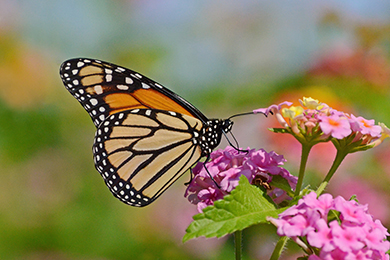
Monarch on Lantana
Lantana (Lantana camara) is a small, broadleaf evergreen shrub in the Verbenaceae (verbena) family that has woody stems but a sprawling habit. It is found growing in tropical climates across the globe and is known for its salt tolerance. Plant it in full sun in well-drained soil.
The showy flowers appear from mid-summer until the first frost and come in a wide range of color from pink, white, yellow, orange red, and purple or mixed colors. Lantana flowers are very attractive to butterflies, berries are eaten by birds. It attracts pollinators as well as being a wildlife food source.
Monarch butterflies must have access to milkweed (Asclepias) as host plants for their caterpillars, but also depend on a variety of nectar plants for sustenance. Lantana is not high on their preference list--but among plants that they will feed on.
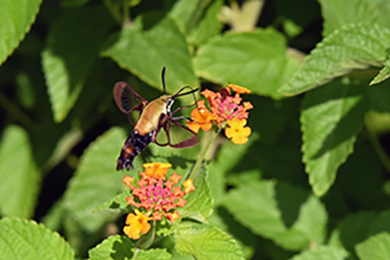
Hummingbird Clearwing Moth on Lantana
Hummingbird clearwing moths (Hemaris thysbe) are hummingbird mimics. Their wingspan is 4 - 5.5 cm so they can easily be mistaken for a bird. Adults fly during the day, and hover at flowers to sip nectar. Caterpillars pupate in cocoons spun at the soil surface.
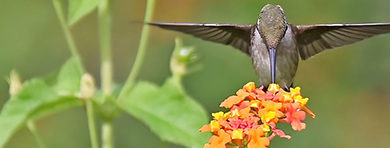
Ruby-throated Hummingbird on Lantana
The Ruby-throated Hummingbird is a small hummingbird with a slender, slightly downcurved bill and fairly short wings that don’t reach all the way to the tail when the bird is sitting. In the Eastern United States, it is the only species of hummingbird found.
Ruby-throated Hummingbirds are bright emerald or golden-green on the back and crown, with gray-white underparts. Males have a brilliant iridescent red throat that looks dark when it’s not in good light. Ruby-throated Hummingbirds live in open woodlands, forest edges, meadows, grasslands, and in parks, gardens, and backyards.
Ruby-throated Hummingbirds (Archilochus colubris) make a spring migration from their over-wintering grounds in Mexico and Central America to the central and eastern United States and southern Canada. Their high energy needs require that abundant supplies of nectar be available throughout the migration corridor, which can range through thousands of miles of habitat. Although Ruby-throated Hummingbirds are well recognized as nectar feeders, they also eat spiders and tiny insects such as flies, gnats and aphids as a source of fat and protein. These foods help hummingbirds to nearly double their weight (from about 3.25 grams to 6 grams) before crossing the Gulf of Mexico. A single migration can become a nonstop flight of up to 500 miles over a period of 18 to 22 hours.
Wildflowers that appeal most to hummingbirds include species with red or orange coloration, long, tubular flower shape, and lots of dilute nectar. Some hummingbird favorites include native wildflowers such as trumpet honeysuckle (Lonicera sempervirens), scarlet beebalm (Monarda didyma), lemon beebalm (Monarda citriodora), wild bergamont (Monarda fisulosa), cardinal flower (Lobelia cardinalis), and trumpet creeper (Campsis radicans). Spring migrations of the Ruby-throated Hummingbird coincide with flowering periods of red buckeye (Aesculus pavia), clove currant (Ribes aureum var. villosum), and columbine (Aquilegia canadensis). The diverse Salvia genus, many of which are native to the western United States, offers many plants that are widely appealing to hummingbirds and other pollinators.
Some scientists believe that as many as 19 species of plants found in the eastern United States have co-evolved with hummingbirds, noting the relationships between the tubular shape of certain flowers and the length and shape of a hummingbird’s bill. The hummingbird laps up nectar by flicking its long, forked tongue deep within a flower at rates up to ten times per second. It forages while hovering airborne, inadvertently collecting pollen on its feathers and bill before darting off to its next meal. Its efficiency as a pollinator is comparable to that of a honey bee.
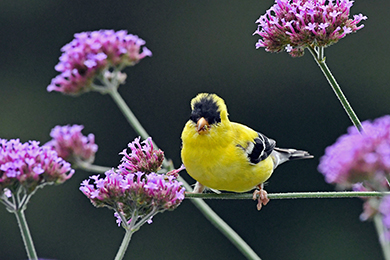
American Goldfinch on Verbena
Verbena (verbena x hybrid) is a common garden annual of the family Verbenaceae. Cultivars are found in blue, gold, yellow, pink, variegated, and white long-lasting showy blooms. It is an important pollinator plant because of its ability to persist until frost, offering both beauty and food for bees and butterflies in the late summer through fall garden. As other plants are in decline and entering dormancy, this beauty becomes the “shiny object” in the garden.
The American Goldfinch (Carduelis tristis) is common throughout North America. Primarily eats seeds from a variety of plants, especially those in the composite family, as well as some insects in spring and summer, fruits, and succulent vegetation. Gleans food from the tips of weed stalks, the ground, and plants. Birds are very important pollinators of wildflowers throughout the world.
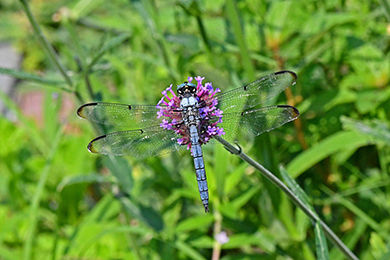
Great Blue Skimmer on Verbena
The Great Blue Skimmer (Libellula vibrans) is a large (18-64mm), brightly-colored dragonfly common throughout the Eastern United States.
Dragonflies are not pollinators, but some consider them beneficial to the garden because adults feed on mosquitoes, gnats, flies, swarming ants, swarming termites…just about any flying insect small enough for them to catch. Nymphs feed on aquatic insects, leeches, bloodworms, snails, tadpoles and even small fish.
Yes, dragonflies are good for your garden most of the time. But you have to consider a few things before allowing dragonflies in your garden.
Dragonflies do not pollinate and can eat pollinators. So, if you have plants that need active pollination, a big group of dragonflies can harm fruit production. A few of them here and there will not do much.
So what should you do? If you have a flower garden, allow them as pollination will not be necessary. If you have a vegetable/fruit garden that does not need active pollination, you can enjoy services from dragonflies. Do a bit of research about your plants.
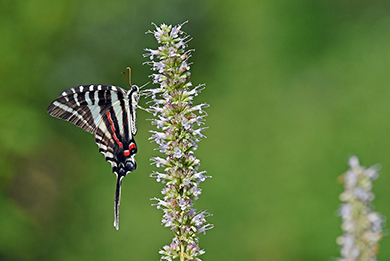
Zebra-Swallowtail on Blue-fortune Hyssop
The Zebra Swallowtail (Protographium marcellus formerly Eurytides marcellus) is native in the Eastern United States and Canada. It lives in moist, low woodlands where its host plant, the paw paw tree, grows. It feeds on flower nectar, avidly visiting flowers and thus becoming "accidental pollinators" as their wings brush aganist pollen and transfer it between plants.
Agastache 'Blue Fortune' aka Blue Fortune Hyssop, Anise Hyssop, Hummingbird Mint is a blue Agastache with fragrant flowers and leaves in the mint family. Tiny lavender blue two-lipped tubular flowers packed in in a spike of 2'-4' tall in rounded whorls. Fragrant, showy and long-lasting.
Plant in full sun to partial shade in well-drained soils. It is tolerant of dry soils and heat once established but it will not tolerate heavy clay or poorly draining soils. It will do well in a raised bed or on a slope to help increase drainage. Flowers are showy and fragrant appearing summer through fall and will be covered in pollinators all day. Deadhead flowers to promote more bloom. Mass plant in a perennial border, along a walkway or near a patio to enjoy the minty-licorice fragrance. It also works well in a cottage garden, butterfly garden or cutting garden. Flowers attract butterflies, hummingbirds, birds, and bees.
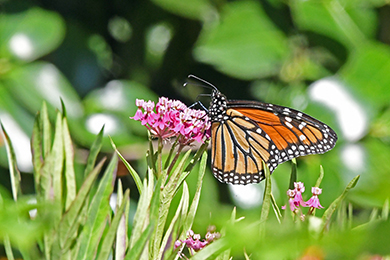
Monarch on Milkweed
Monarch caterpillars ONLY eat milkweed. In fact, the monarch butterfly is also known as the “milkweed butterfly.”
The milkweed plant provides all the nourishment the monarch needs to transform the Monarch caterpillar into the adult butterfly.
But these plants are rapidly disappearing, due to the loss of habitat stemming from land development and the widespread spraying of weed killer on the fields where they live.
It’s easy to grow your own Milkweed!
There are many varieties of milkweed. There are some which thrive in full sun, in humid conditions and even in very dry conditions. As a perennial, they will come back every year, despite harsh winter conditions. They typically bloom rosy pink flowers, and are the preferred host plant for the monarch butterfly. To find out more about the various species of milkweed and which are best for your area, check out this factsheet courtesy of Monarch Joint Venture.
Photos courtesy on Jim Easton
